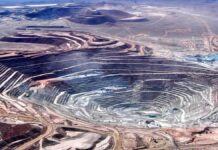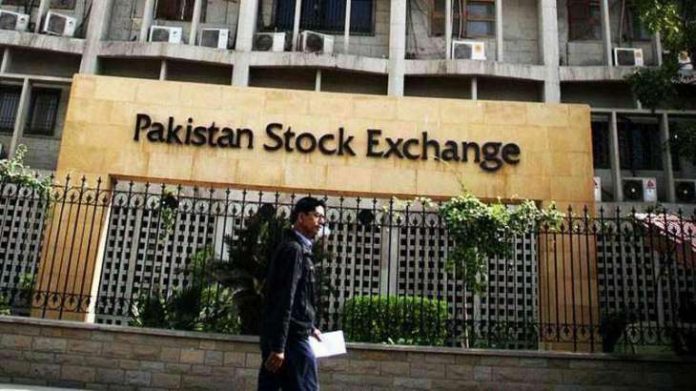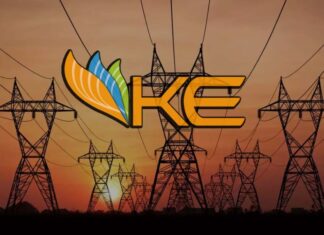KARACHI: The stock market extended its rally on Friday, with the benchmark KSE-100 settling higher by 839.12 points at 31,621.79 points.
Among other indices, the KMI-30 Index gained 1,910.14 points to close at 49,722.53, while the KSE All Share Index accumulated 526.39 points, ending at 22,515.59. Of total traded shares, 205 advanced and 89 declined.
Friday’s rise in the benchmark index’s value meant that the KSE-100 accumulated 3,512 points during the outgoing week — highest-ever jump in the exchange’s history. In terms of percentage, the index rose 12.5pc during the outgoing week — highest since 18 February 2000, when the market had risen by 13.7pc.
“Low valuations, relaxations, government’s relief package, and lower than expected impact of coronavirus outbreak” were the reasons that Sami Tariq, Head of Research and Business Development at Arif Habib Limited, cited behind PSX’s upward trajectory.
Tariq predicted that “cement and steel are expected to benefit from the construction package, whereas E&P sector will benefit from the recent increase in international oil prices from its lows”.
According to Shahrukh Saleem, Equity Analyst at AKD, “The market rebounded due to a variety of factors which included i) recovery in oil prices; news report suggest there is a meeting among global oil producers on Monday and production cuts are expected to be under discussion, ii) restrictions being eased for several industries in KP and Punjab leading to resumption of production, and iii) expectations of a construction package which is being linked with increased demand for construction materials including cement.”
Industry expert Adnaan Sheikh stated, “After losing nearly a quarter of its value, falling 23pc in March 2020 (worst month since the 2008-09 crisis), selling has exhausted for now and punters are keen on taking bets given the government is providing various stimulus and relief packages to key industries, such as the anticipation of a construction package boosting cements. This is further heightened due to the hopes of an OPEC deal.”
However, Naushad Chamdia, CEO of Standard Capital, believed that market players took the recent “plunge in the PSX” as an opportunity. He said the KSE-100 at 27,000 became very attractive on fundamental valuations in the aftermath of the coronavirus factor.
“From investors’ perspective, the downside was only marginal i.e. 10pc-15pc, but upside was massive. Hence high networth investors bought heavily at lower levels and made a big sweep in a few days given a surge in construction material companies especially where the PM relief package was much awaited, along with the sudden decrease in SBP policy rate,” he added.
Talking to Profit about sectors, he opined, “Cement companies close to dam locations performed better by hitting upper circuits at the exchange. E&P also rebounded on attractive valuations even after WTI resided at $20/bbl due to Dollar denominated wellhead prices. HNI took huge advantage of attractive valuations.”
WHAT’S DRIVING THIS GAIN?
- Currency and policy rate
Industry expert Adnaan Sheikh noted that the currency was down by approximately 7pc in March, adn that “oil sector earnings are boosted by higher USD”.
With the State Bank of Pakistan slashing policy rates by 225pc within the span of a month, there was a concern in the market regarding foreign divestment from T-bills. Market players, however, were concerned regarding the hot money outflow and the subsequent impact it would have on currency. Some expected the currency to slide beyond Rs170 per USD.
This was due to the fact that not only would hot money leave the economy due to policy rates going low, but also due to foreign investors needing liquidity due the global market conditions.
Total gross divestment during March 2020 reached $1.735 billion, according to data released by the State Bank of Pakistan (SBP), in what proved to be an extremely tough month where foreign outflows left Pakistan almost every second day.
Seeing as to how the money pouring out did not slump the currency further, market sentiments regained. Sheikh added that the market often functions based on these anticipations.
- Oil prices
Crude prices posted their strongest day gain on record on Thursday following US President Donald Trump stating that he believes that Saudi Arabia and Russia are to announce a major oil production cut. Oil rallied by 25 percent following a tweet from Trump.
Oil prices have been slashed to less than half their value in 2020. This is a result of the Coronavirus exponentially spreading and dampening economic sentiments, thereby resulting in muted demand expectations. This was further accelerated by the Kingdom of Saudi Arabia and Russia engaging in a price war. As a result US crude prices found itself trading at less than $20 per barrel a number of times during March.
Trump further commented that having spoken to Saudi Crown Prince Mohammed bin Salman, he expects Saudi Arabia and Russia to cut oil production nearing 10 -15 million barrels as the countries have demonstrated willingness to form a deal. What is interesting is that Trump did not mention the production in terms of barrels per day, the usual market jargon.
This was followed by the Saudi State media announcing that an emergency meeting of the Organization of the Petroleum Exporting Countries (OPEC) has been called in order to deal with the mounting turmoil in the market. The market anticipates that the Kingdom will further slash its output by 3 million bpd than what was planned for April, bringing output to roughly 9 million bpd.
- Coronavirus and relief packages
Top gainers this week included Kohat Cement, rising by 43pc followed by Cherat Cement and Saif Powers both rising by 37pc. This is due to the industry expecations with regards to the construction package that is to be announced.
Prime Minister Imran Khan on Thursday announced that the government will announce a Rs. 100 billion package for the construction industry in order to ensure the country remains afloat in wake of the coronavirus pandemic. Khan states, “We have decided we will give necessary incentives to the construction industry in order to provide job opportunities to people during this time of crisis.”
The PM further added that the government has decided to open the construction industry and provide the appropriate incentives that will result in job opportunities for citizens. This will act as a sigh of relief for allied industries. Khan added that this decision was taken keeping in mind that activities such as the construction of road infrastructure does not add to the risk of the spread of the virus.
The government has further taken an unprecedented step whereby all outstanding sales tax refunds have been cleared. The Rs. 100 billion refund announced on Thursday for the business community designed to ensure liquidity crisis does not deter the functioning further added to confidence in industries, and subsequently the market.
Considering the controlled spread of the virus, and the government’s serious attitude to ensure the economic sentiments are not held hostage to lockdowns, the market has been on an upward rebound, after falling drastically.
- Third party evaluations
Moody’s Investors Service on Thursday said in a new report that the recent measures taken by the State Bank of Pakistan (SBP) will help Pakistani banks. The global rating agency’s research arm said, “We expect the measures to mitigate banks’ asset-quality deterioration amid less business generation and loan growth in an economic slowdown.”
“Pakistan’s strong and decisive policy measures have started to yield positive results in reversing macroeconomic imbalances and narrowing current account deficits,” said ADB Country Director for Pakistan Xiaohong Yang in a press release issued on Friday. “Although Pakistan’s economy is in better shape than before, the nation needs to work together to tackle the new challenges posed by COVID-19—including uncertain short term growth prospects—and its related socioeconomic repercussions. The government’s emergency package and extensive use of Ehsaas programme will be vital to blunting the detrimental impacts of the pandemic, particularly on the poor and vulnerable.”
The relative positivity in these statements has also increased investor confidence and appetite. Thereby resulting in the market rallying.
Is this the end of March Madness?
The PSX witnessed its worst decline in March 2020 since December 2008. The index plummeted 8,752 points over the span of a month and gave a negative return of 23 percent MoM. This is equivalent to a 28.8 percent decline in USD.
While Pakistan is not alone in this downward trend witnessed in equities, it is the largest negative decline in the Asia Pacific Region for the month of March.
However, the CY20 decline until March leaves returns down by 28.2pc or 33.3pc in dollars.
The reason for this decline can be attributed to the spread of COVID-19 across 195 countries. While confirmed cases in Pakistan have surpassed the 2000 mark, the uncertainity around the economy and the lockdown in different parts of the country have further led to the market declining.
























